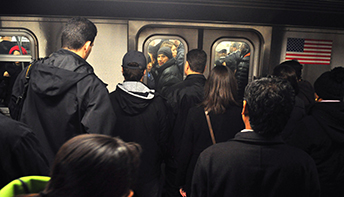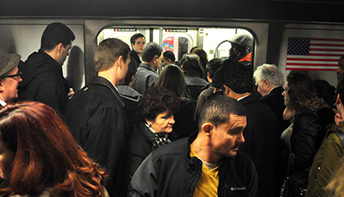Dec. 19, 2012 — Two weeks ago, Remapping Debate published a story detailing how a fully built-out version of the Second Avenue subway — one that can be built quickly and which would maximize benefits to the residents of New York City — remains only a dream. It was clear that the primary cause was a lack of political and budgetary will, but we deferred our reporting on how New York politicians explain this failure.
Both before and since the publication of that article, Remapping Debate conducted extensive outreach to elected officials representing New Yorkers at the federal, state, and city level. Most — including many of those who hold themselves out as advocates of mass transit — never returned repeated requests to comment on the future of the project.
Very few were prepared to discuss how more persistent advocacy in favor of needed mass transit projects, like a full build-out of the Second Avenue subway, could move the existing political dynamic away from the idea that needed mass transit projects are “unrealistic.”
The New York area politicians that did respond to interview requests confirmed the arguments of transportation planners, engineers, and the MTA in identifying the benefits of completing the Second Avenue subway. They pointed to the economic development potential up and down the East Side, reduced commute times for workers, increased accessibility for residents, and reduced overcrowding on the Lexington Avenue Line subway platforms and cars. Furthermore, politicians discussed the costs incurred by not proceeding with the line, including escalating expenses, missed opportunities to borrow funds at historically low rates, and delays in delivering the expected benefits to the city and its residents.
Richard Brodsky, a former state assembly member who represented parts of Westchester County and who is now a senior fellow at Demos, a liberal think tank, was not surprised at such uniform responses to questions about the benefits of completing the Second Avenue subway or the costs of delaying it. He told Remapping Debate, “I don’t think you are going to get significant numbers of people saying that the Second Avenue subway is a bad idea.” What will happen, he added, is “you are going to get significant numbers of people saying, ‘How are you going to pay for it?’”
Choices, not inevitabilities
As we have reported, only a small segment of the Second Avenue subway — from 96th Street to 63rd Street — has been funded. It will open in 2016. That the MTA has not been funded to proceed with a full build-out is a matter of priorities, not necessity, and is certainly “not inevitable,” according to Brodsky. Dan Quart, a state assembly member whose district includes the Upper East Side and East Midtown, agreed, telling Remapping Debate the pace of the project is constrained largely by “limits” in our “thinking of what is possible to accomplish.” Quart said that more money could be allocated for the project.
José M. Serrano, a State Senator whose district includes East Harlem and parts of the Bronx, added that what holds the project back is “that there isn’t a lot of political will.”
“Unfortunately,” he continued, “we’ve seen this move [to] where more and more Democrats are aspiring to sound like many Republicans” by deploying the “no-spending mantra.” Responding to austerity rhetoric, he said, requires a “push back” with the argument “that the vast majority in our community favor raising revenue for public work projects that will keep our city vibrant and…an economic capital.”
Scott M. Stringer, the Manhattan borough president who is now a candidate to be New York City’s comptroller in the 2013 election, has been outspoken on the need to expand not only the Second Avenue subway, but create other subway lines as well. In April 2012, he told the Association for a Better New York, a New York City civic advocacy organization, that, “[W]e should not give up on thinking big and expanding our subway system.”
In that speech, he proposed a variety of measures to increase funding for transit investment that would rely on money from the city and state — including the creation of a New York City infrastructure bank and a reinstatement of the commuter tax. These investments, including the Second Avenue line, are necessary, Stringer wrote in an email message to Remapping Debate, because the subway system, though an “urban marvel…no longer meets the needs of the 21st century, five-borough economy.”
Such a funding plan would represent a major departure from the current norm. As Brodsky explained: “As important as the Second Avenue subway is, and it is, the MTA’s capital needs go well beyond that, and that there is no fully funded MTA capital plan is a real problem.”
So where is the money?
State support for the MTA has been declining for years, and the MTA’s five-year capital plan, out of which “state of good repair” improvements, normal replacements, as well as expansions are funded, is being increasingly financed through MTA bonds (the Authority’s debt now stands at $32 billion). But because the MTA is responsible for the debt service on those bonds and does not get help in doing so from the state’s general fund, such payments now account for $2.1 billion (17 percent) of the MTA’s annual operating budget, up from $797 million in 2003.
As reported in the first part of this series, the City’s current contribution makes up about 4 percent of the MTA’s capital budget. Neither Mayor Michael Bloomberg or City Council Speaker Christine Quinn, nor prospective mayoral candidates Bill de Blasio (also the current city public advocate) and Bill Thompson (the former city comptroller) granted interviews to Remapping Debate or replied to emailed questions asking whether the City is meeting its need for mass transit and what, if anything, they were doing to advocate for funding a full build-out of the Second Avenue subway.
Brad Lander, a City Council Member from Brooklyn who is a member of the transportation committee, told Remapping Debate that a variety of city transit projects deserve attention, not just the Second Avenue subway. “I am eager to see, in general, an expansion of the transit system capacity,” Lander said.
“What we need now more than ‘this project’ or ‘that project’ is a big commitment to invest the resources to expand the system…I’d rather focus on that than say, ‘I want this or that.’ I would like this and that.”
He suggested that there was room for the city to contribute more to the MTA’s capital program, but also added that “[expansion] projects are expensive, and I think you need city, state, and federal commitments if we are going to have a chance of getting things done on the scale needed.”
Gale Brewer, a city council member representing the Upper West Side and, with Lander, a member of the City Council’s transportation committee, agreed that the city needs a fully built-out Second Avenue subway, but added that it was only one of a number of unmet needs. Brewer asserted that the city doesn’t have the funds to contribute more to the capital budget, and said that, because the MTA is a state agency, projects like the Second Avenue subway need to be “state pushed.” James Vacca, the chair of the transportation committee on which both Lander and Brewer serve, did not return repeated requests for comment.
Given the mass transit status quo — limited capital available for keeping the existing system in a state of good repair, let alone expanding it — Remapping Debate sought Governor Cuomo’s view as to whether forcing needed transit projects, including the Second Avenue subway, to compete with one another for tight funding meant that the state was condemning its citizens to a wholly inadequate infrastructure. His office did not make a representative available for an interview and did not respond to this emailed question or others asking what, if anything, the Governor had done to advocate for a fully built Second Avenue subway project.
Remapping Debate also reached out to Assembly Speaker Sheldon Silver, whose district includes neighborhoods on the Lower East Side of Manhattan and who was a crucial source of support for the full Second Avenue subway during its planning and design phase during the late 1990s and early 2000s. Among other things, we wanted to know whether making a constant and loud claim for needed transit expansions would begin to expand the public sense of what choices government has available to it, but Silver did not respond to requests for an interview.
Silver, in a statement in 2004, boasted to constituents that he had “already personally secured $1.05 billion for [the Second Avenue subway] in the current MTA 5-year capital plan. It is important that we capitalize on this commitment, and not let this opportunity to improve our transportation system get away.” More recently, however, transit advocates criticized the Speaker for letting a state bill designed to protect existing dedicated transit funding for the MTA be watered down by the Governor.
Other legislative leaders, including the chairs of the senate and assembly transportation committees, Charles J. Fuschillo, Jr. and David F. Gantt, respectively, did not return requests for an interview or respond to written questions.
Federal dollars
New York City has over time received significant federal funding for new mass transit projects, garnering over $1.3 billion for the first phase of the Second Avenue subway (from 63rd Street to 96th Street) and $2.6 billion for the East Side Access project that will bring Long Island Railroad trains to Grand Central Terminal in 2018. Nevertheless, the funds received represent only a small part of what Representative Carolyn B. Maloney (D-N.Y.) described to Remapping Debate as “billions of dollars of unmet needs” for transit infrastructure. The remaining phases of the Second Avenue subway (north to 125th Street, and south to Lower Manhattan), as we have reported, are unfunded and would cost some $12 billion.
Remapping Debate contacted both of New York’s senators and 10 out of 13 congressional representatives who represent parts of the city for this story. Most did not reply or chose not to comment, and those who did respond were not prepared to imagine an alternative to the piecemeal and inadequate approach to transit expansion already underway.
Maloney, in an email message, wrote that she sees the “cup half full rather than half empty” when it comes to federal transit funding and that a “partial build” of the Second Avenue subway “is significantly better than no build.”
The future’s not bright
The MTA officially remains committed to a full build-out of the Second Avenue subway. But all current signs about what politicians and even advocates believe is “realistic” should lead to great skepticism that the commitment will be realized.
Representative Yvette Clarke (D-N.Y.), for example, wrote in an email response that due to “the extensive damage to our city’s infrastructure” as a result of Hurricane Sandy, “New Yorkers will be placed in the uncomfortable position of tolerating a host of infrastructure deficits.”
And even Gene Russianoff, the chief spokesperson for the Straphangers’ Campaign of the New York Public Interest Research Group and one of the best-known advocates for mass transit in New York City, isn’t pushing a full build-out of the Second Avenue subway now.
“I don’t apologize for trying to deal with the politics as I find them,” he told Remapping Debate, “and there is only so much you can change.”

